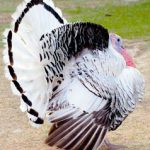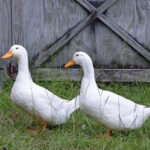
The Royal Palm is a lightweight turkey with stunning white plumage trimmed in black. Turkeys with a similar color pattern have been raised in Europe since the 1700s, known there variously as black-laced white, pied, or Crollwitzer. The first turkeys in the United States with the palm color pattern appeared in the 1920s in […]
Continue Reading

In comparison to other poultry species, little is known about how turkeys were originally domesticated. What is known is that wild turkeys are indigenous to the Americas and were kept by Native Americans centuries before the arrival of Europeans. Various tribes ate turkey eggs, as well as enjoying turkey meat, both cooked fresh and dried […]
Continue Reading

A picture-perfect Pilgrim-era turkey, the Narragansett was developed by early settlers as a cross between Norfolk Black turkeys brought from Europe and local wild turkeys. Having its origins in Rhode Island, the turkey was named after the state’s Narragansett Bay. It was once a common feature in farmyards, but eventually lost favor to more cost-effective […]
Continue Reading

- Bronze Heritage Standard Turkey – Sold as Baby Poults Only – No Sexing Available
Seasonal/Shipped April thru Late July
Your total order requires ANY 3 birds to ship.
LIMIT OF 20
Continue Reading

The best laying turkeys don’t lay nearly as well as the best laying chickens. Plus, given that a turkey is bigger than a chicken, and therefore eats more than a chicken, keeping turkeys strictly for eggs is not a practical endeavor. However, if you have turkeys anyway, you may as well enjoy their delicious eggs. […]
Continue Reading

Starve-out occurs when turkey poults (baby turkeys) fail to eat. As a result they literally starve to death. But, as dire as it sounds, preventing starve-out is not difficult with proper poult management. Reasons for Starve-Out Poults learn how to eat from the mama hen. Since chicks are quicker learners than poults, “I recommend including […]
Continue Reading

More than chicks, turkey poults (baby turkeys) can be tricky to brood. Even though they’re bigger than chicks, they’re much more delicate. They are extremely sensitive to temperature changes, dampness, and drafts. And they have a lesser instinct for danger. “Let’s face it,” says Jeff Smith of Cackle Hatchery®, “turkey poults are not the brightest.” […]
Continue Reading

What exactly are heritage chickens? For that matter, what is a heritage turkey, duck, or goose? By definition, heritage poultry breeds share these important characteristics: They are standard breeds They mate naturally They can live a long time They are slow growing Standard Breeds Heritage breeds must have been accepted into the American Standard of […]
Continue Reading

The Swedish duck has its origins in the early to mid 1800s in Pomerania, a region on the Baltic Sea that was once controlled by Sweden. The breed first came to the United States in 1884. The only variety listed in the American Standard of Perfection is the blue variety, accepted in 1904. Physical Attributes […]
Continue Reading

The White Pekin is the quintessential duck that most people think of when they hear the word “duck.” This big white duck derives from an ancient Chinese breed, the name of which translates as “ten-pound duck.” The first Pekins in the United States arrived in the early 1870s, hatched in the Chinese city of Peking, […]
Continue Reading










